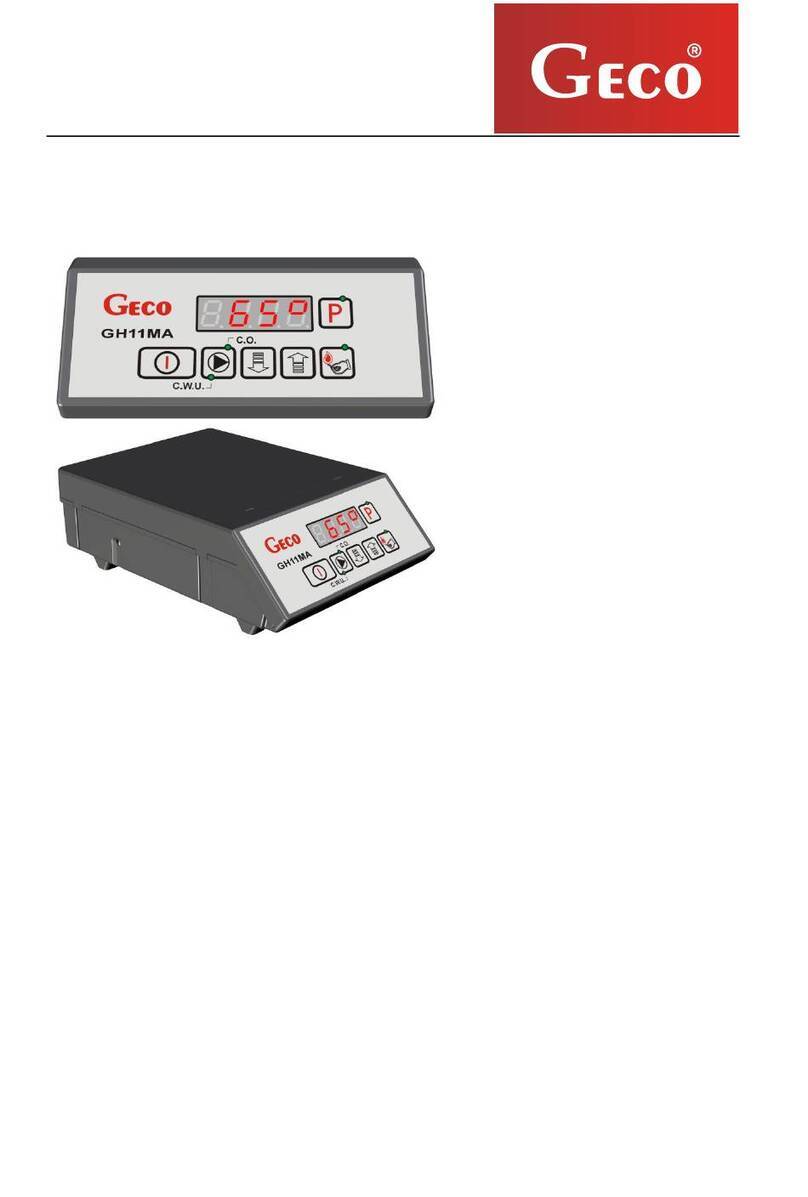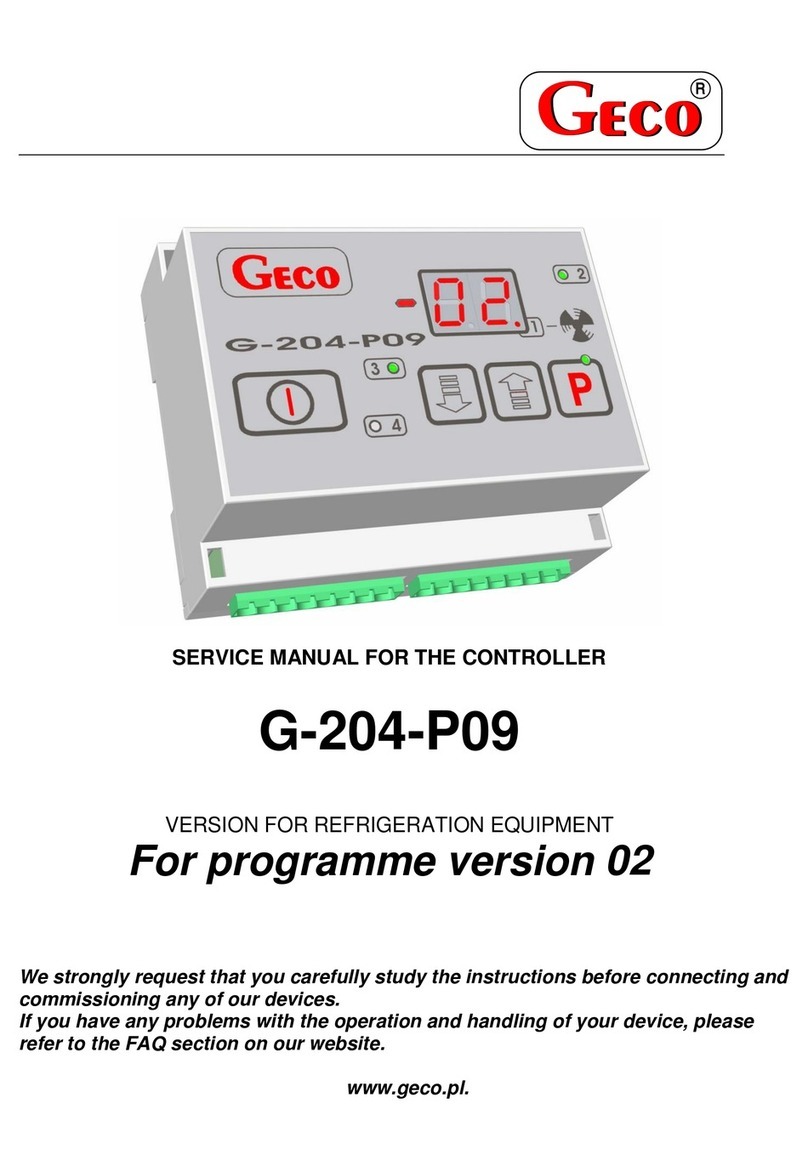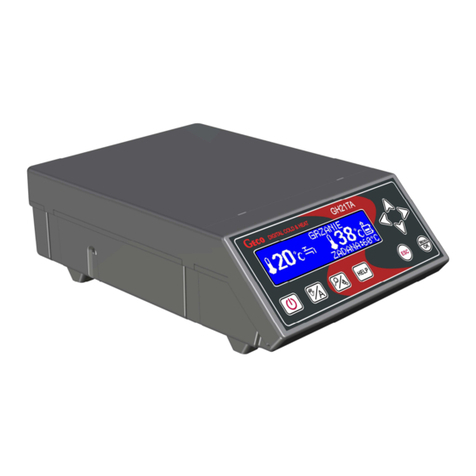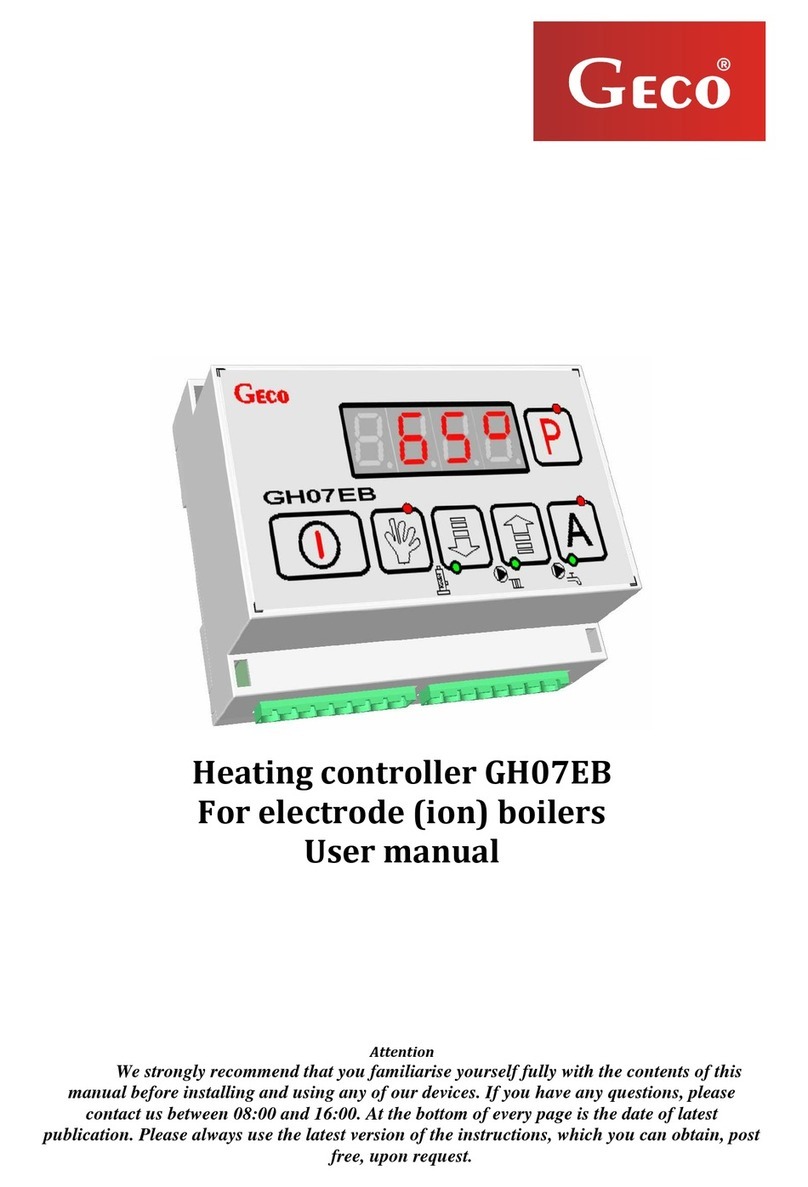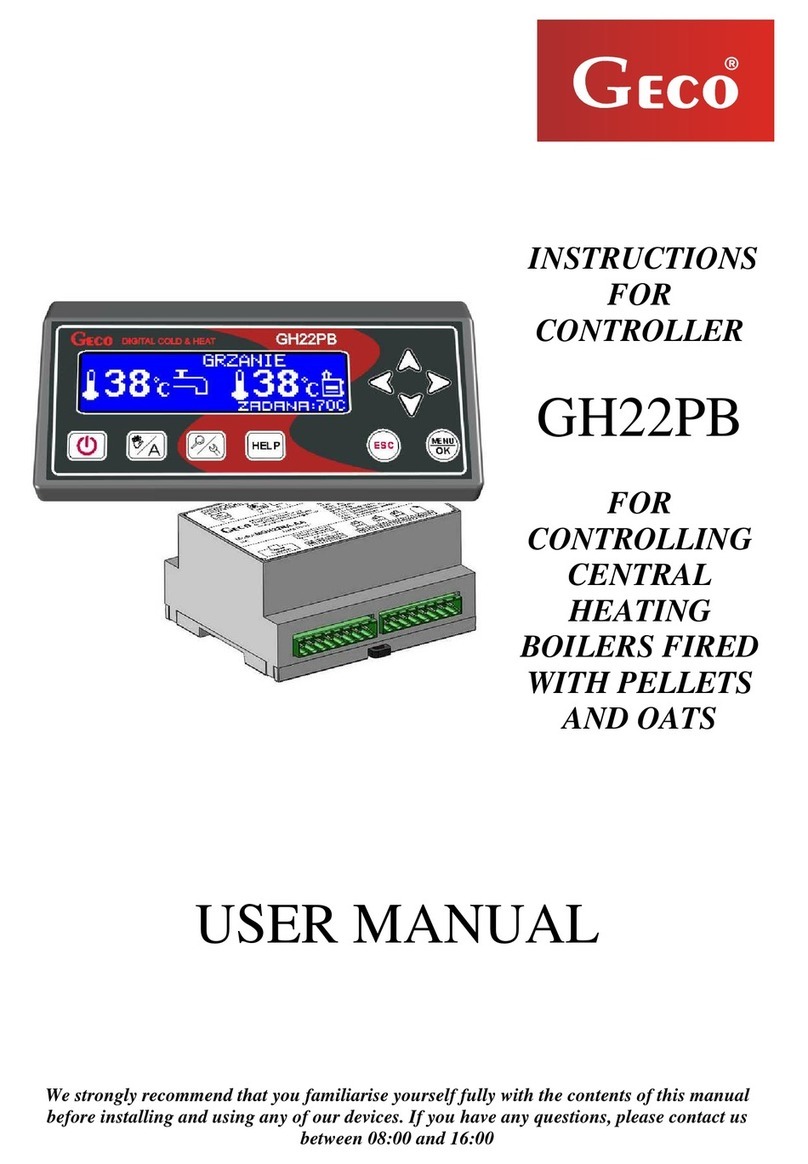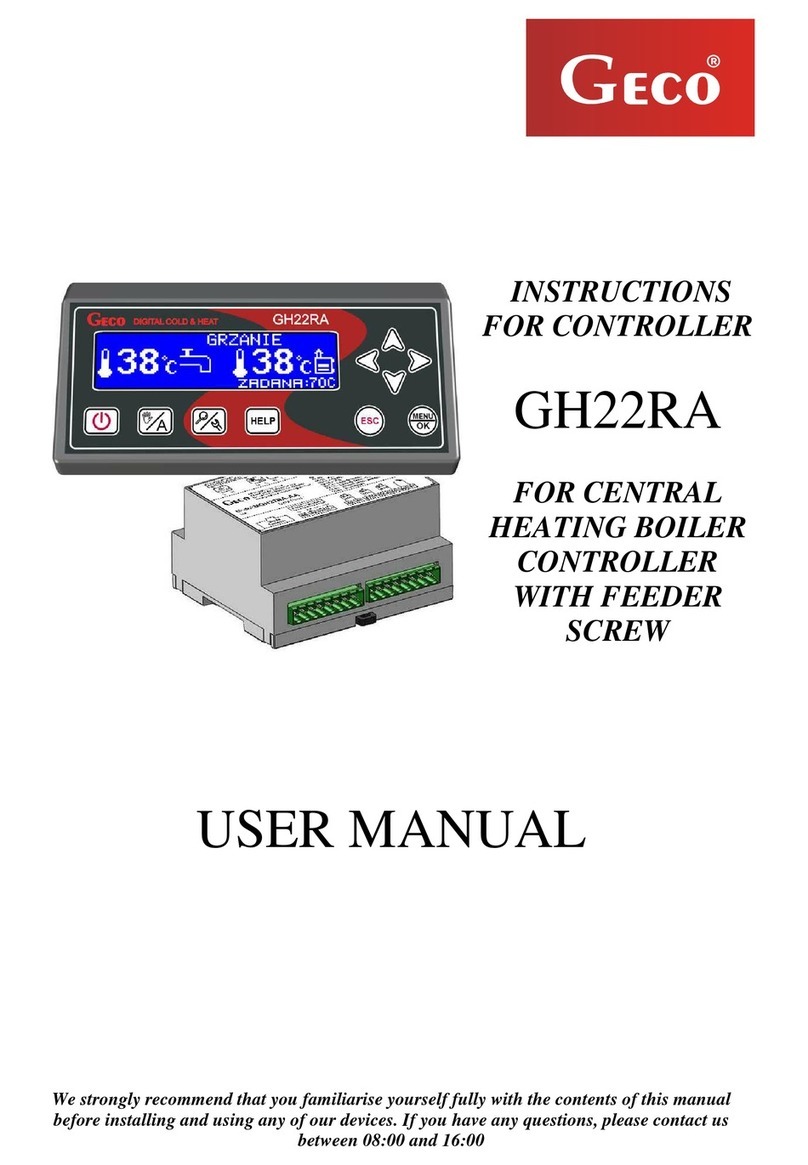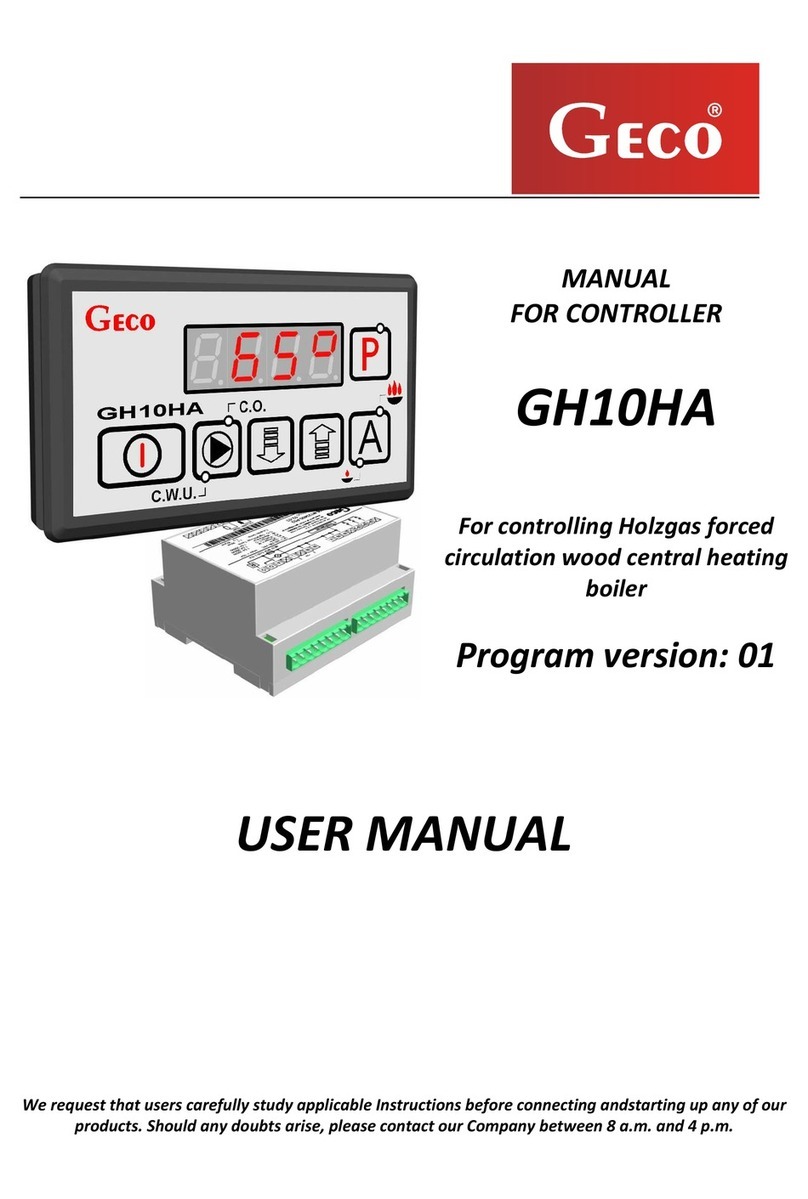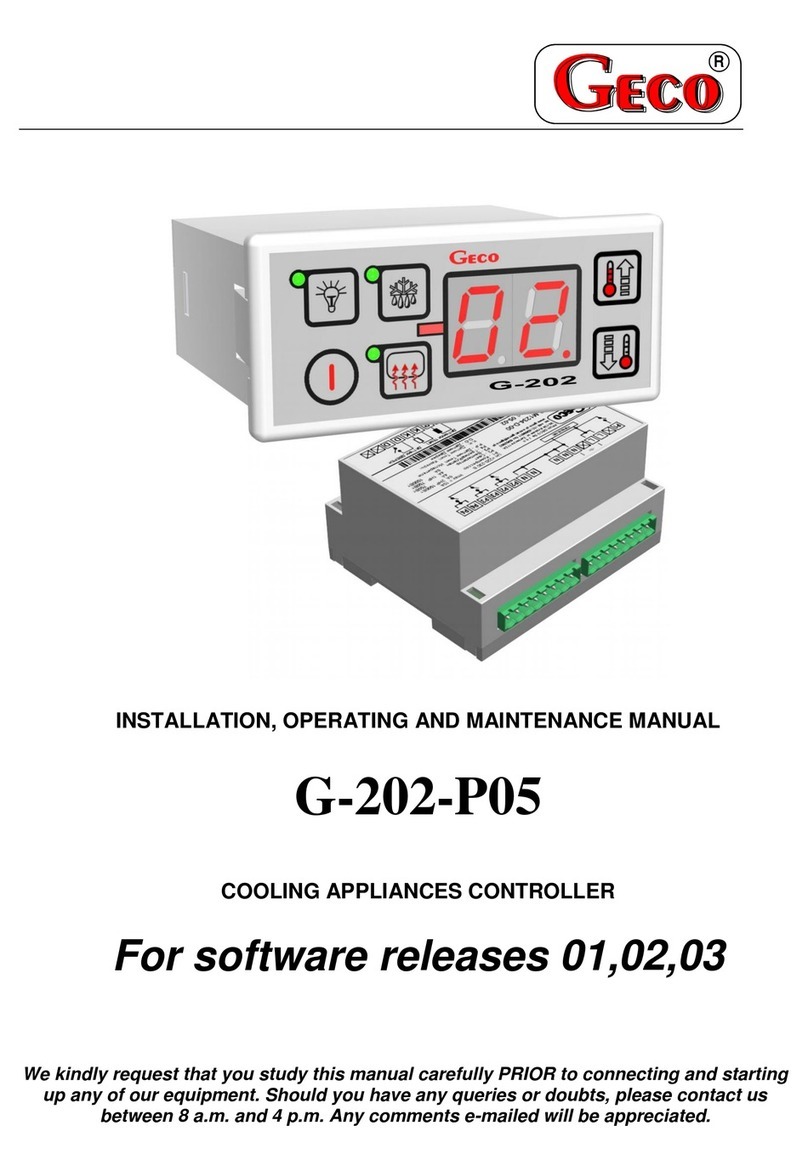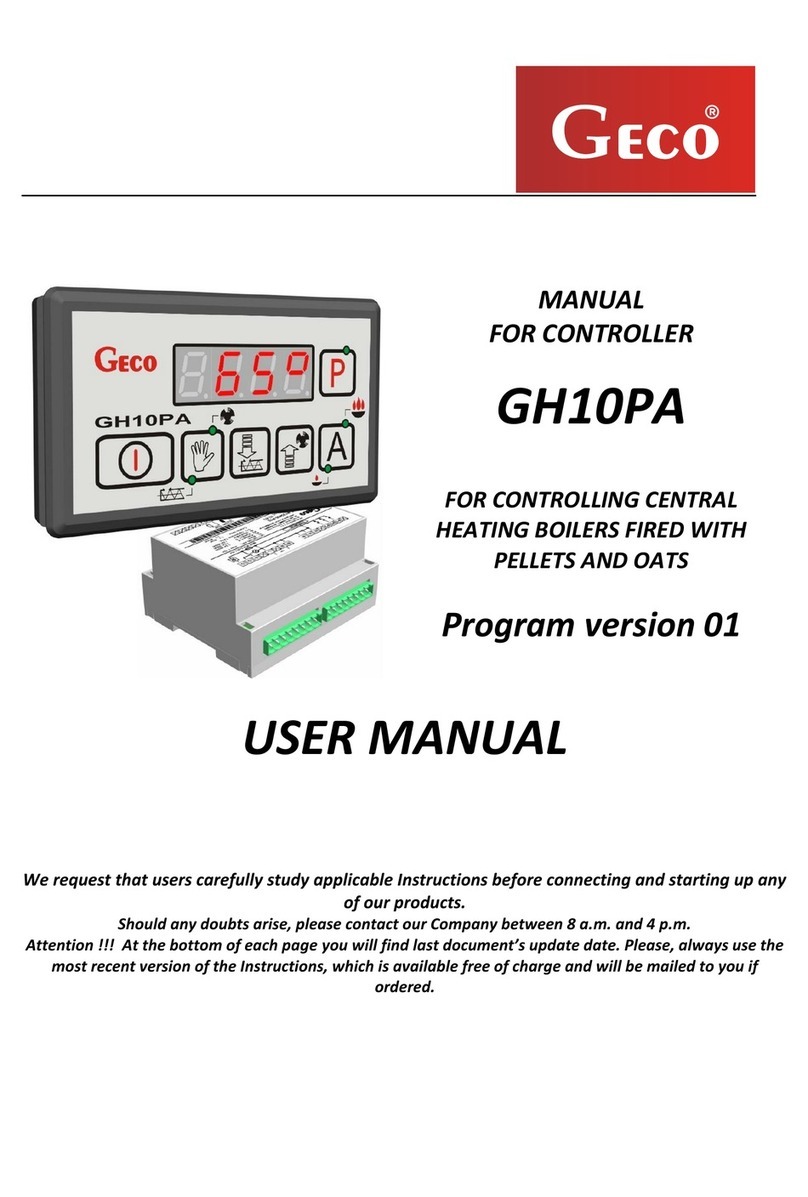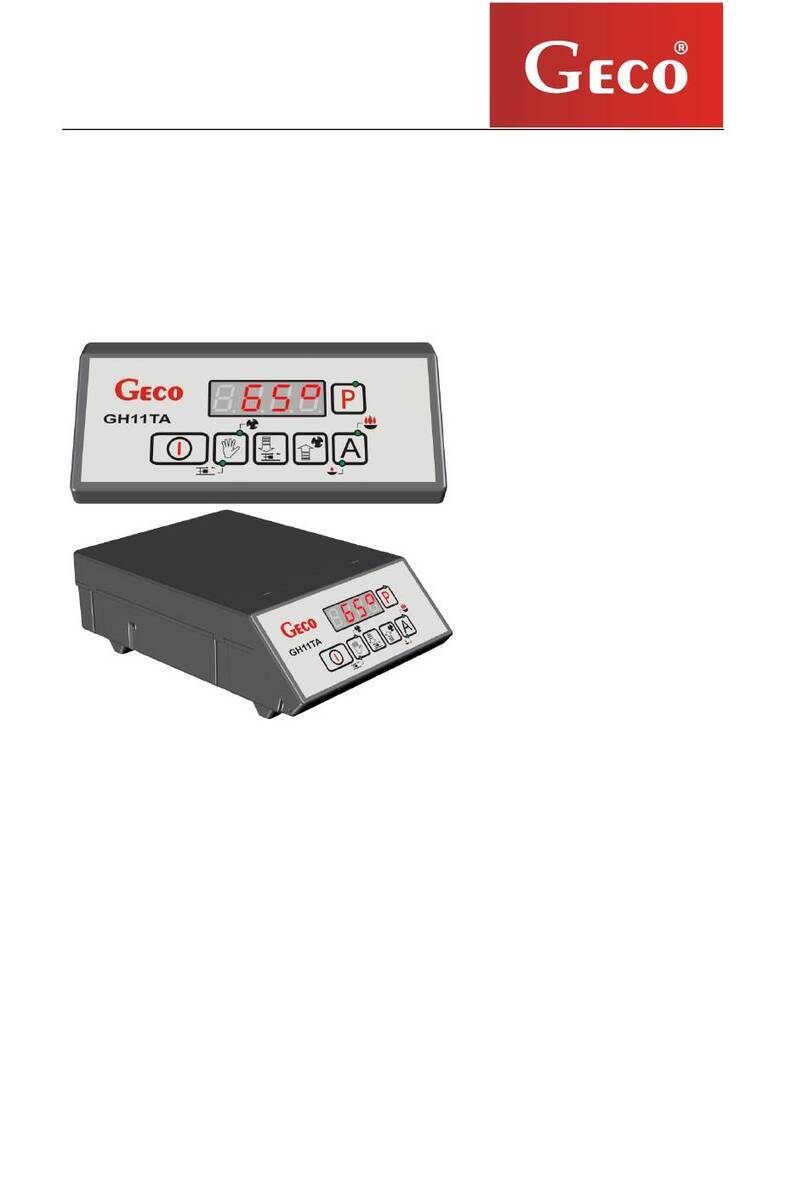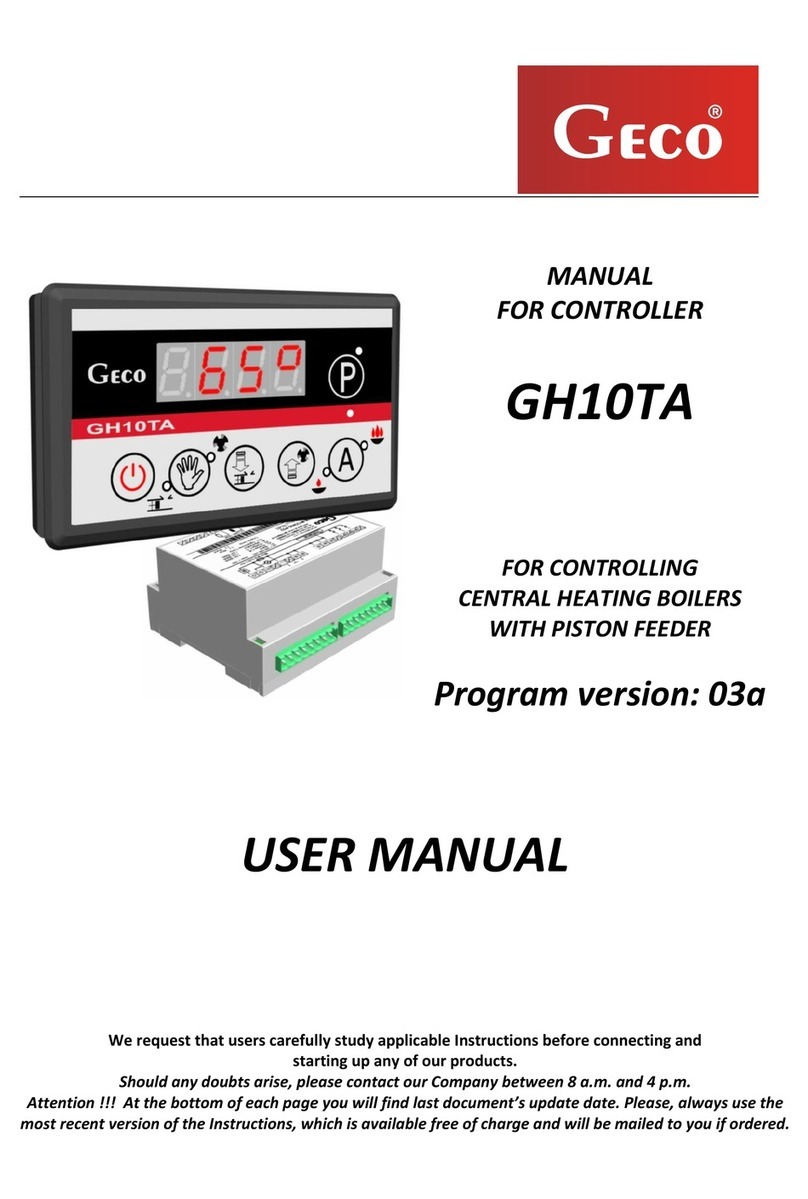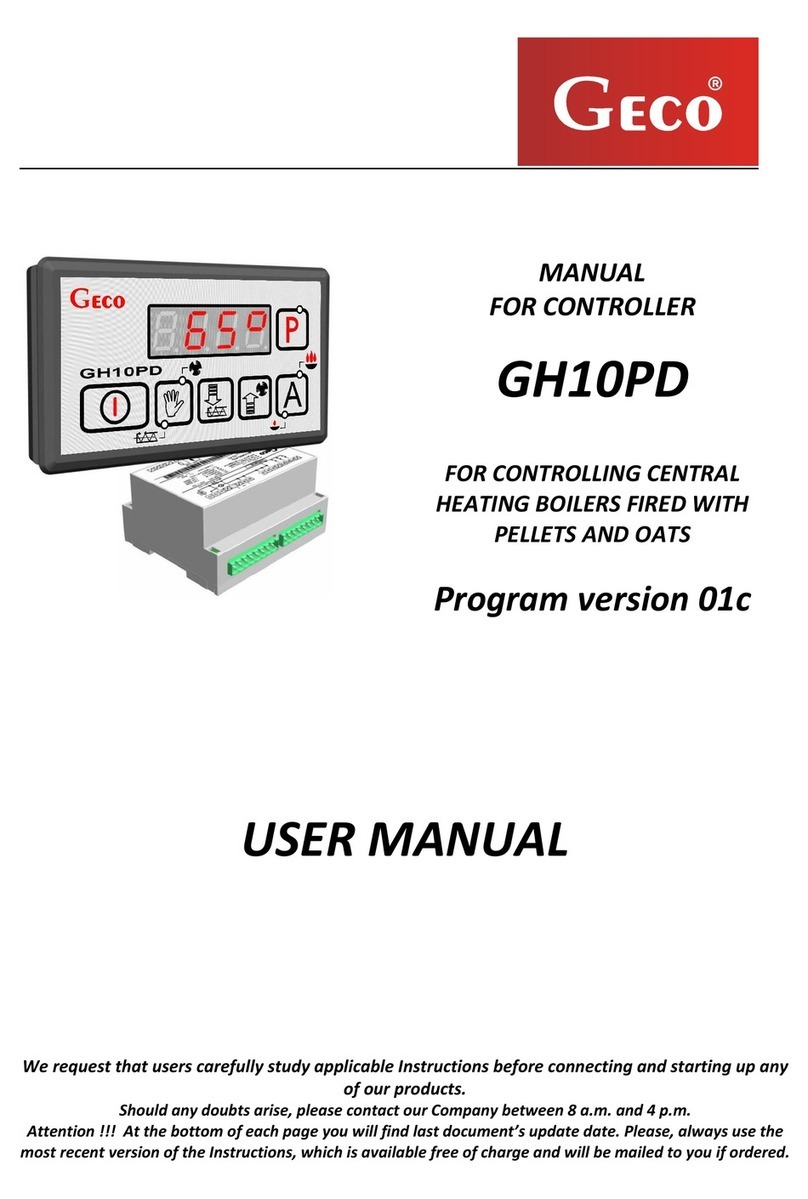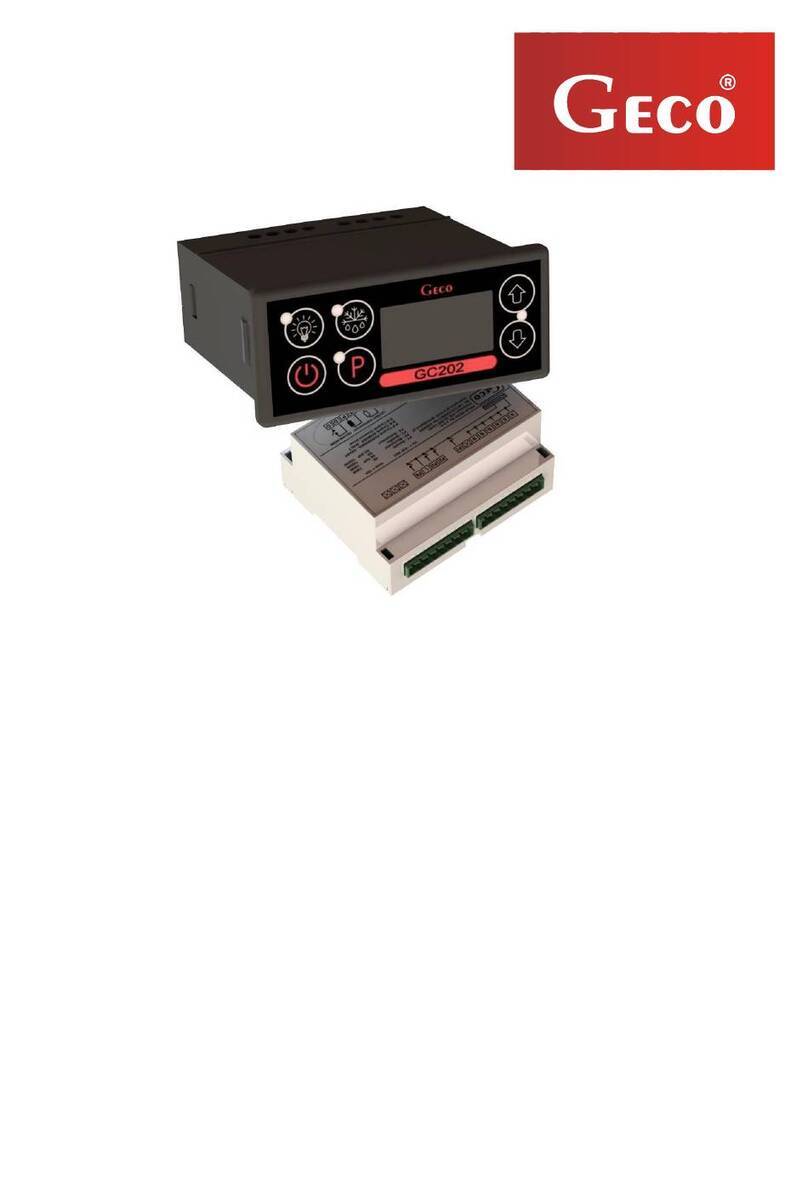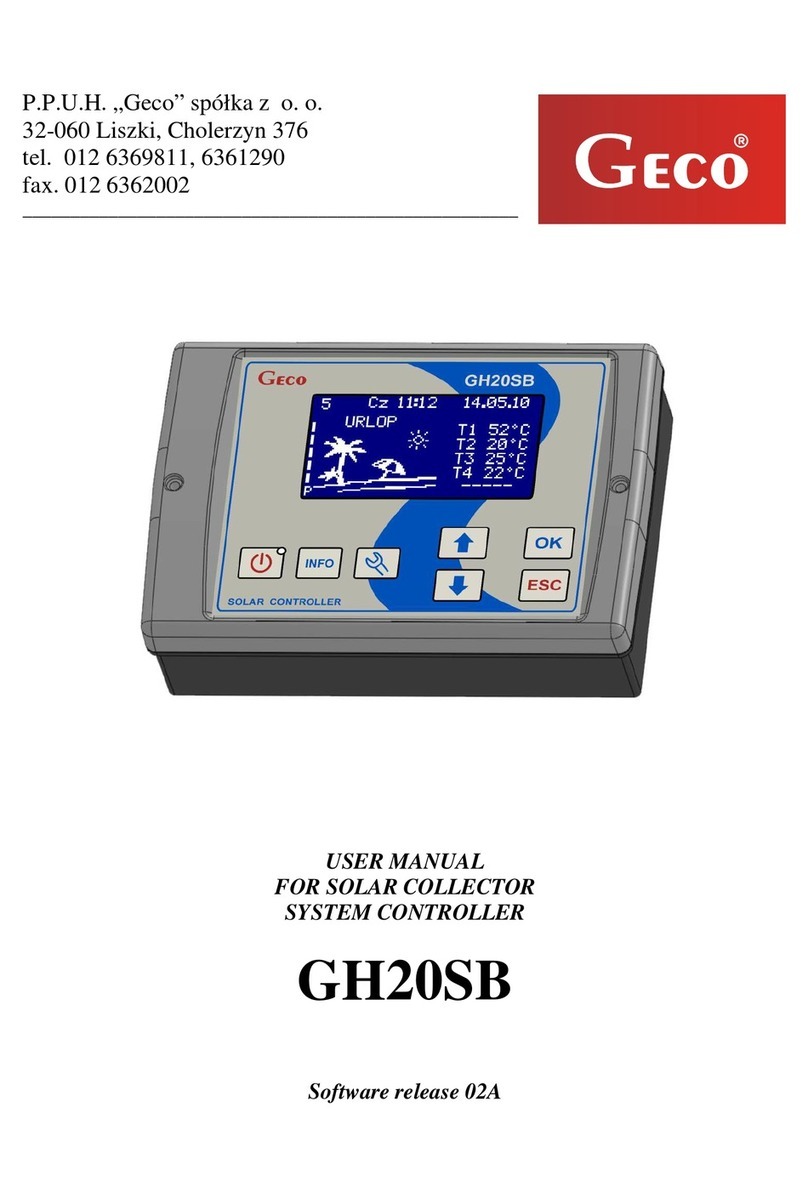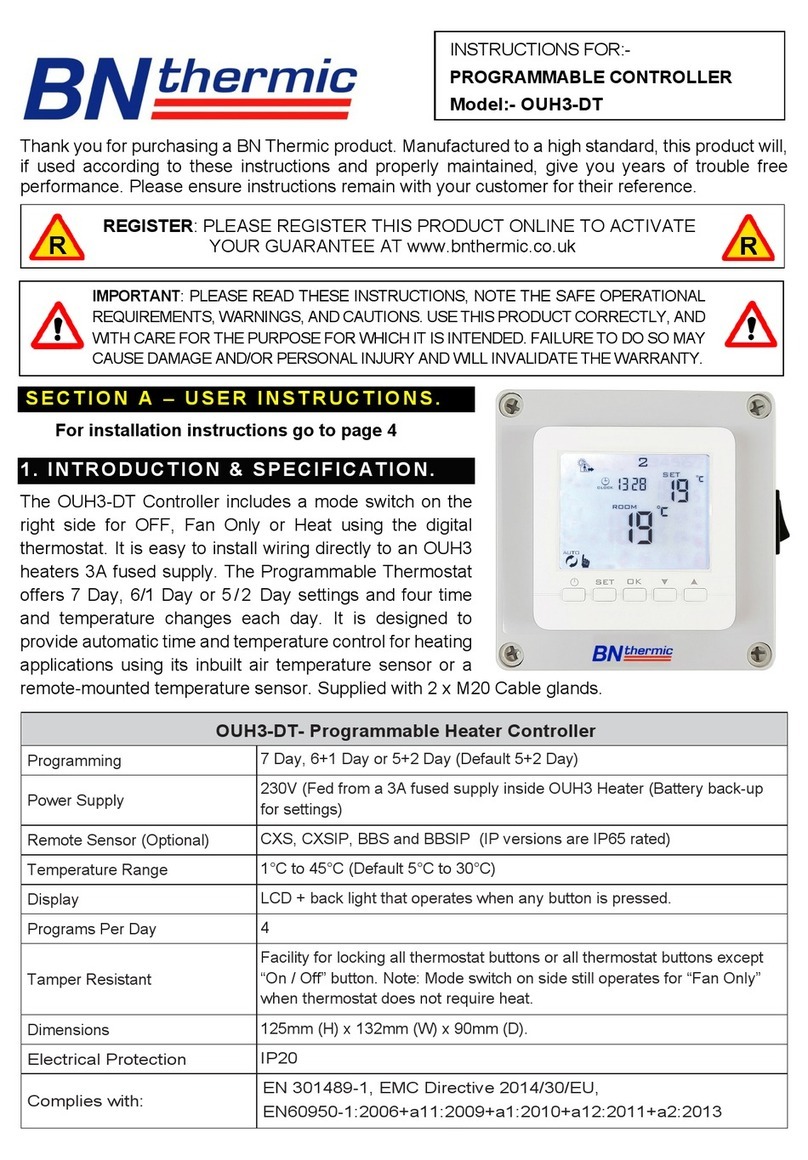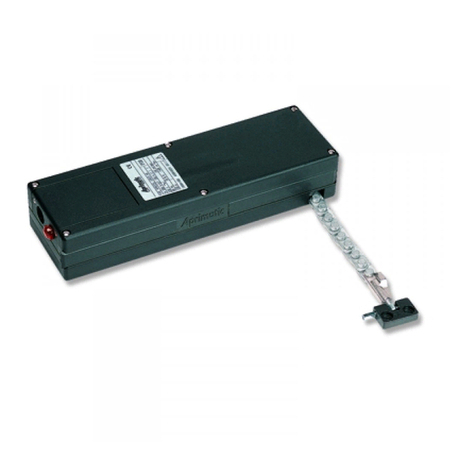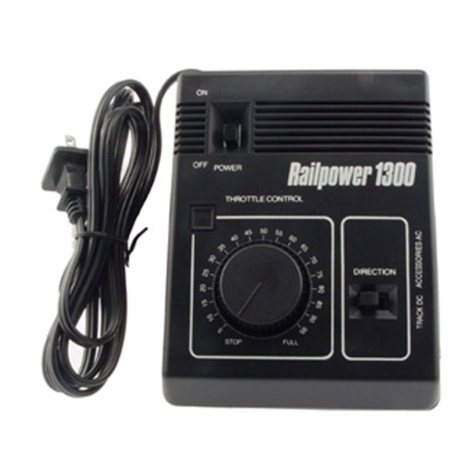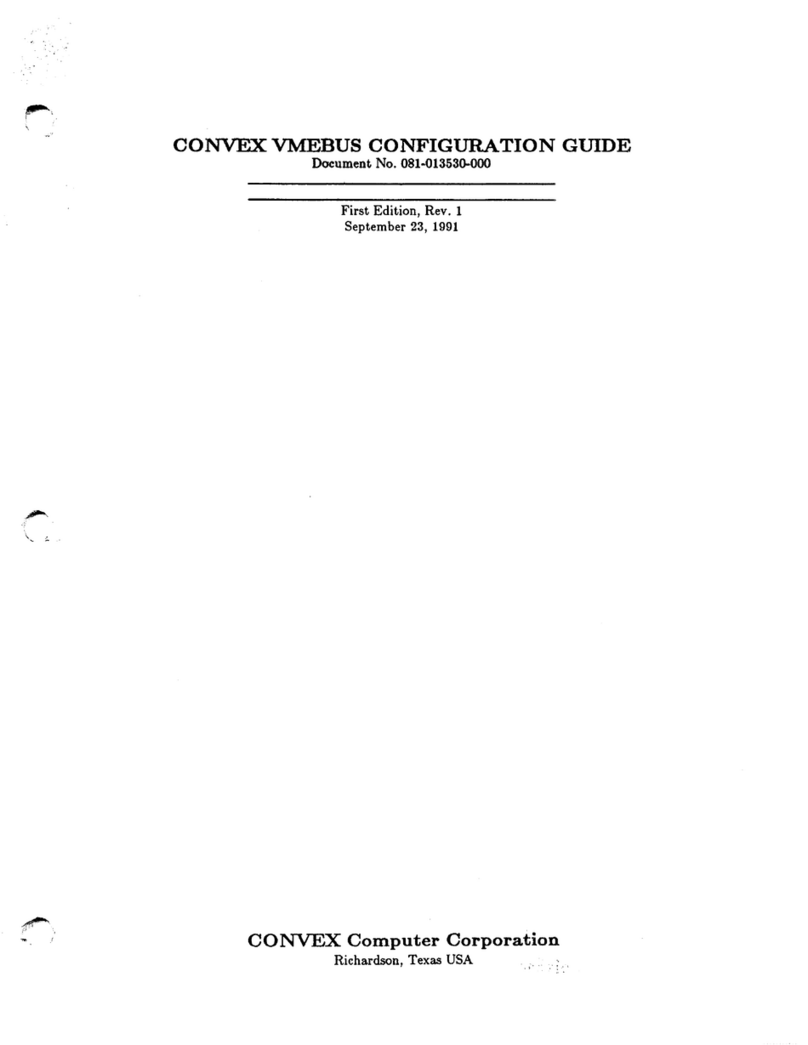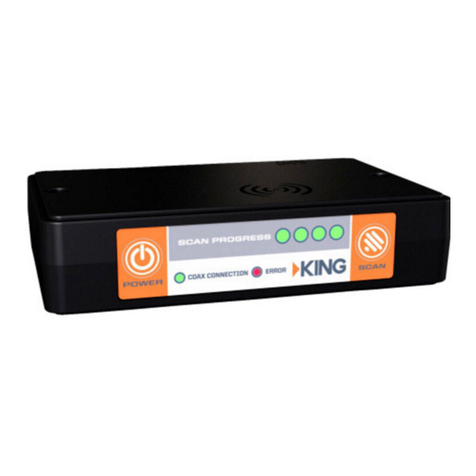Geco GC207 Installation guide

INSTALLATION, OPERATING AND MAINTENANCE
MANUAL
GC207
COOLING APPLIANCES
CONTROLLER
For software version 02
Please, read the manual very carefully before connecting and starting any of our
devices.
In case of doubt please contact our company between 8am and 4pm.

Page 2
3rd edition
AS FROM 01.12.2017
Contents:
I. GENERAL FEATURES...........................................................................................................................3
II. MARKING AND SPECIFICATIONS.....................................................................................................3
III. HOW TO ORDER....................................................................................................................................4
IV. DELIVERY, INSTALLATION AND CONNECTION...........................................................................4
V. INSTALLATION OF SENSORS, TYPES OF COVER SHELLS ..........................................................5
VI. GENERAL OPERATION PRINCIPLES.................................................................................................6
A. General Information ...............................................................................................................................6
B. Defrosting...............................................................................................................................................7
C. Principle of operation of the door opening sensor..................................................................................8
D. Hysteresis ...............................................................................................................................................8
VII. ON/OFF DIAGRAMS FOR INDIVIDUAL ASSEMBLIES OF THE APPLIANCE .............................9
VIII. SETTING THE SYSTEM PARAMETERS...........................................................................................10
IX. TROUBLESHOOTING..........................................................................................................................12
X. RETURNING FOR REPAIR..................................................................................................................14
XI. METHOD OF PRODUCING THE RIBBON CONNECTING THE PANEL AND THE ACTUATOR
MODULE................................................................................................................................................14
XII. BLOCK DIAGRAM OF THE STANDARD VERSION OF THE ACTUATOR MODULE ...............16
XIII. BLOCK DIAGRAM IN THE EXTENDED VERSION OF THE EXECUTIVE MODULE................17

Page 3
3rd edition
AS FROM 01.12.2017
I. GENERAL FEATURES
ATTENTION!!! Since this manual applies to several very similar types of thermostats, from hereon
we will only refer to the name of the more complex thermostat
designated as GC207.
The Standalone Control Block (SBR), hereinafter referred to as GC207, is a modern, convenient
and easy-to-use device. The Controller is a microprocessor-based device manufactured using Surface
Mount Technology (SMT).
Thanks to the two-piece housing and innovative technical solutions, GC207 can be used in any piece
of furniture and in a simple cold room. Operating under a safe 5V voltage, the control panel can be
mounted anywhere, without the need for cutting additional holes and guiding many power supply
cables far from the controlled appliances.
GC207 is equipped with two temperature sensors, the possibility of connecting the door opening
sensor to the control panel or executive module –they work then under a safe 5V voltage and five
outputs enabling direct connection of devices operating under 230V with the load capacity as in Table 1.
When used in refrigeration equipment, GC207 stabilises the temperature and controls automatic
defrosting, the period of which can be adjusted to specific ambient conditions; it also has a button for
manual defrosting of the evaporator.
Versions with a light switch operating independently of the main switch are available.
These thermostats do not require any special maintenance; the keypad is made of a special type of
foil resistant to high temperatures and most chemical agents. Never use sharp items to clean the foil,
just wipe the front panel with a moist cloth.
II. MARKING AND SPECIFICATIONS
Model designation: GC207.0X
0X –number denoting the version of the controller
01 –4-relay controller controlling the following devices:
compressor/fan/heater or valve/second compressor
The keypad of the controller panel is made without the light button.
The standard DD input allows the connection of an additional sensor, the selection of which
depends on the r6 parameter. Depending on the setting of this parameter, we can connect a
door opening (mechanical or magnetic) sensor or an additional temperature sensor acting as
a thermometer (for r6=3).
02 –5-relay controller controlling the following devices:
compressor/light/fan/heater or valve/second compressor
The keypad of the controller panel is made with a light button.
The standard DD input allows the connection of an additional sensor, the selection of which
depends on the r6 parameter. Depending on the setting of this parameter, we can connect a
door opening (mechanical or magnetic) sensor or an additional temperature sensor acting as
a thermometer (for r6=3).
03 –5-relay controller controlling the following devices:
compressor/light/fan/heater or valve/second compressor
Controller panel keypad made with light button.
The standard mounted input 1-2-3 allows the connection of an additional sensor, the selection
of which depends on the r6 parameter. Depending on the setting of this parameter

Page 4
3rd edition
AS FROM 01.12.2017
we can connect an optical door opening sensor or an additional temperature sensor acting as a
thermometer (for r6=3).
Operating voltage
230V +10% -15%
Operating temperatures
+5°C to +40°C
Humidity
20% to 80% RH
Ingress protection
IP65 at the front of the control panel
Type of temperature
sensors
NTC 2.2kΩ – measurement range: -400C to
+600C
Table 1: Designation of relays and output loads
EXIT
RELAY
RECOMMENDED MAXIMUM CONTINUOUS LOAD
P1 –Compressor
30A
8A
2HP
1500W
P2 –Light
16A
4A
–
750W
P3 –Fan
16A
4A
1HP
750W
P4 –Heater/Valve
16A
8A
–
1500W
P5 –Compressor
30A
8A
2HP
1500W
Attention!!!
Currents given in the table are the currents consumed by individual devices
during normal operation and include the starting currents of these devices!!!
The total current consumed simultaneously by the devices must not exceed 10A!!!
III. HOW TO ORDER
The order should specify:
1. Full name of the controller, e.g. GC207.02.
2. Length of the ribbon connecting the executive module and the keypad panel (the standard
length of the ribbon is 1m).
3. Length of temperature sensors (standard sensor lengths are 2.5m and 3.0m).
4. Length of the cable to the door opening sensor (standard: to the reed switch 2.0m; to optical
sensor 2.5m).
5. You can also order additional door opening sensors operating in an entirely contactless manner:
magnetic sensor with range of 1-2cm,
optical sensor with a range of 1-2cm.
IV. DELIVERY, INSTALLATION AND CONNECTION
1. Cut a hole measuring 20x30mm in the designated place in the device, and if the panel masking is
not used, the hole should be 58x109mm.
2. The executive module should be placed on the rail and locked with a latch. In the case of store
devices, it is REQUIRED to mount the SBR executive module with the mounting strip facing
down!!!
3. Any metal elements through which the GC207 or its cables are passed should be filed down or
otherwise secured.

Page 5
3rd edition
AS FROM 01.12.2017
It is not permitted to mount the GC207 allowing the direct impact of water on it (e.g. water
condensing on the lower cover of the display case), touching the evaporator drain pipe, etc. and
causing significant changes in its temperature in relation to the ambient temperature (e.g.
mounting in the immediate vicinity of the compressor and its accessories, cooled and heated
elements).
4. Cut the ribbon connecting the panel with the executive module to the desired length plus 2-3cm.
Then, after putting it through all the passages, cut its ends again at a right angle and clamp the
plugs on it so that the end of the ribbon is hidden inside them for about 0.5mm. The ribbon must
be introduced perpendicularly to the plug and tightened without the possibility of any twisting or
non-parallel arrangement. Connecting the ribbon to the connectors see CHAPTER XI.
5. After mounting the GC207, connect the power cables in accordance with the description on the
casing of the executive module. Depending on the GC207 version, some outputs may not be used
–they will not be described on the label with the description, and in the type designation
zeros will be inserted in the appropriate places –no wires must be connected to these outputs!!!
6. Remember to connect the jumper supplying the P5 relay –see the sticker on the casing of the
executive module. If this jumper is not connected, there will be no power at the P5 output.
7. All cable surpluses are shortened by cutting or rolling and fastening them with special plastic ties.
The cables must be securely fastened along their entire length and must not touch the
compressor and its accessories.
8. After connecting the device to the power supply, there may be voltage on the lighting cable,
regardless of switching the device on or off with the button, therefore the starter or
fluorescent lamp can be replaced only with the power cord disconnected from the socket!!!
THE SAME CONDITION APPLIES TO ANY OTHER REPAIRS!!!
9. If heaters are used, their power must be selected so that in the event of a failure of the GC207 or
the contactor and switching them on permanently, there is no possibility of fire or destruction of
the device. If high-power heaters are used, it is absolutely necessary to use a safety thermostat
on the evaporator, this thermostat should operate differently, e.g. a mechanical thermostat.
V. INSTALLATION OF SENSORS, TYPES OF COVER SHELLS
1. For each type of manufactured device, the place of mounting the chamber and evaporator sensor,
as well as the SBR setting should be selected experimentally. It is absolutely forbidden to change
the place or method of mounting the sensors and SBR settings without conducting new tests
regarding temperature stabilisation and defrosting of the device!!!
2. Mounting the chamber sensor must be carried out in such a way that it does not touch the food and
is not exposed to damage during cleaning of the device.
A special plastic holder can be used to attach this sensor. This solution results in a fast (time delays
on/off see chapter VI point 7 and 8) reaction in the sensor and the entire thermostat to a change in
the air temperature in the device. If it is advisable or necessary to slow down and “smooth” the
reaction time of the sensor to temperature changes, we suggest screwing it to a metal element of
the device.
3. The evaporator sensor should be mounted in a way that ensures maximum solid and reliable
contact with the evaporator lamella and in such a place where the ice stays the longest during
defrosting. Its attachment should prevent it from being pushed out by accreting ice. Sensors should
be mounted vertically, if possible, with the cable coming out at the bottom of the sensor.
4. The sensor cables can be shortened or extended in any way, however, observing the following
rules:

Page 6
3rd edition
AS FROM 01.12.2017
-
do not cut the sensor cable at a distance of less than 0.5m from the shell
-
it is not recommended to extend the sensor cable beyond 20m.
-
THE WAY OF CONNECTING THE SENSOR CABLES TO THE SENSOR TERMINALS OF THE ACTUATOR MODULE IS
FREE!!! (similar to the method of inserting the plug into the ~230V socket)
-
to extend the cables, we suggest using an OMY 2x0.5mm cable
-
connection of cables in case of extension should be done very carefully, each pair of wires is
soldered and heat-shrinkable sleeves are put on them; then, the place of connection should be
flooded with waterproof silicone and another heat-shrinkable sleeve should be clamped on it
-
ends of the wires connected to the SBR should be whitened with tin.
VI. GENERAL OPERATION PRINCIPLES
A. General Information
1. After connecting power supply the device performs a 3-second initialising procedure during which the
display shows two dots for a second, controller software release for another second, and two dots
again. During this time, none of the controlled devices is switched on.
2. After performing the start-up procedure from point 1, two horizontal dashes will light up in the middle
segments of the display, indicating the “energized” state – if the device has not been previously
switched on!!! The device is started by pressing the button . The display shows value of the
temperature indicated by the chamber sensor.
3. After pressing and holding for 0.5 seconds, the display will start flashing and show the
temperature of the evaporator, after another 5 seconds GC207 will automatically return to reading the
temperature from the chamber. Attention!!! This function also works during defrosting when 'dF'
lights up on the display. You can also see the temperature from the chamber sensor by pressing
for 0.5 seconds, the display will start showing (without blinking) the chamber temperature, after
another 5 seconds GC207 will automatically return to displaying 'dF'.
4. Compressor activation is indicated by lighting of a small red diode (dot) in the lower right corner of
the temperature display. This allows easier checking of possible system malfunctions.
5. If the compressor is to be switched on, the P5 compressor is switched on and then, after 6 seconds, the
P1 compressor. Similarly, in case of switching off, P5 is switched off first and after 6 seconds P1.
6. Should the compressor be switched on, but it is not due to the activation of one of the protections (see
point 7, 8), the dot indicating the compressor operation will blink. After the set protection time has
elapsed, the dot will light up permanently and the compressor will be turned on.
7. The delay in switching on the compressor after reaching its activation temperature (temperature set
by the user minus the lower hysteresis value) is 30 seconds. If the temperature drops during that
period, the system re-checks if the 30-second condition has been exceeded. This is to protect the
compressor from unnecessary activation, for example caused by putting goods in, draughts, etc.
8. Every time the temperature setting is reached (the user temperature setting plus the upper hysteresis
value) and after every power outage or drop below 175V, the GC207 allows to re-activate the
compressor for the time determined by the 'c2' parameter. However, if the 'c2' = 0min, then the
protection after power outage continues for 60 seconds.
9. After switching on the device with the button, there is a 5-second delay in switching on the
compressor. Please note that this will cancel the current loss protection from point 7 –this also applies
to the time specified by the 'c2' parameter after the compressor has been turned off. This allows
quicker checking of the compressor operation.

Page 7
3rd edition
AS FROM 01.12.2017
10.The controller is equipped with alarms indicating sensor failures. The behaviour of the controller will
be different depending on which sensor has been damaged.
If the chamber temperature sensor is damaged, the A1 message will be displayed. The controller
will turn on the compressor in a time cycle (so-called timer control) according to the times
specified in the 'c8' and 'c9' parameters. Defrosting will operate normally.
Failure of the evaporator sensor will cause the A2 alarm to be displayed. Manual and automatic
defrosting operation is blocked!!! The only way to defrost the device is to turn it off with the
button and wait for the ice to melt naturally.
If there is a failure of two sensors at the same time, only the A1 alarm will be displayed. Once the
chamber sensor is repaired, the A2 alarm will be activated.
11. If a buzzer has been installed in the controller –see Chapter II, the controller signals pressing each
button by beeping the buzzer. When the controller is turned off (two horizontal lines on the display),
the buzzer signals only pressing and .
12. The lighting is switched on and off after pressing the button. This is signalled by a green LED next to
the button. If the light is switched on due to the door opening, this LED does not light.
The button works independently of the thermostat's power switch .
B. Defrosting
1. If additional defrosting is required due to difficult working conditions, press the button. The green
LED on the button will then be on continuously and the display will show 'dF' instead of the
temperature measurement, at which point the device will enter the defrosting cycle.
2. If defrosting takes place and the temperature on the evaporator is higher than the value set in the 'd2'
parameter, the device will enter the defrosting exit phase after about 10 seconds and once completed, it
will resume operating.
3. If defrosting occurs and the temperature on the evaporator is lower than the value set in the 'd2'
parameter, the GC207 will start defrosting and after reaching the temperature specified in the 'd2'
parameter, it will enter the defrosting exit procedure (this state is signalled by the blinking of the
green diode on the button), in the version with heaters, the defrosting exit procedure is performed,
consisting of two successive phases:
dripping phase –in which the compressor and evaporator fans are off for the time set by the 'c3'
parameter
evaporator freezing phase –in which only the compressor operates in order to lower the
evaporator temperature to the temperature defined by the 'd5' parameter before restarting the fans.
The maximum and non-extendable freezing time, regardless of the evaporator reaching the 'd5'
temperature, is defined by the 'c4' parameter.
4. The procedure of exiting the defrosting is completed by starting the fans, turning off 'dF' on the
display and switching off the blinking of the green LED on the button.
5. In the absence or not of fans connected to the SBR, the system will behave as if they were installed.
6. Defrosting will be completed after reaching the temperature set in the 'd2' parameter on the
evaporator or after exceeding the time set in the 'c1' parameter.
7. After switching off 'dF' and the end of defrosting, the display will show the temperature stored just
before the start of defrosting for the time specified in the 'c7' parameter –this is to prevent complaints
due to “rapid temperature jumps in the device”'.
8. The system behaves in the same manner for manual and automatic defrosting.

Page 8
3rd edition
AS FROM 01.12.2017
C. Principle of operation of the door opening sensor
1. If the door is opened, the fan stops immediately and in GC207, depending on the setting of the 'r7'
parameter, the light may be turned on. The temperature reading is shown in the display.
2. After 30 seconds, if the door has not been closed, the word 'dr' is displayed continuously on the
display. For the controllers with buzzer installed, a short beep is emitted and repeated every 30
seconds.
3. If the door has still not been closed after the time specified in the 'r8' parameter, the alarm is
activated, signalled by the flashing of the display with the word 'dr' and by a beep in the version of
the controller with a buzzer. At the same time the compressor is switched off.
4. If, after opening the door, R8 = 0 the alarm is immediately activated.
5. You can cancel the alarm by pressing any key. Closing the door deactivates the alarm and restores
normal operation.
6. The Controller allows connection of both a mechanical door opening sensor, which is closed when
the door opens (r6=01), as well as a mechanical or magnetic sensor which is opened when the door is
opened (r6=02).
D. Hysteresis
When programming the 'd0' and 'd1' parameters (the minimum and maximum temperature that can be set
by the customer), remember that the 'd3' hysteresis value causes an additional 'pull' of the temperature
down and up from the temperature set by the user.
This is of particular importance in the case of devices 'plus', which should always work above 0ºC.
As a manufacturer of a refrigeration device, in this case a cooling counter (positive temperatures), we
require that the device enabled operation be only within the range of temperatures that do not exceed the
below specified values: Switch off min.: 2ºC. Switch on max.: 10ºC
Symmetrical hysteresis for even values of 'd3'
Symmetric hysteresis for odd values of 'd3'
Example 1.
For example, the 'd3' hysteresis is set to 2ºC
For the above hysteresis setting you should also set
the parameters: 'd0' at 3ºC and 'd1' at 9ºC
Example 3.
For example, the 'd3' hysteresis is set to 3ºC
For the above hysteresis setting you should also set
the parameters: ‘d0' at 3ºC and 'd1' at 8ºC
Example 2.
For example, the 'd3' hysteresis is set to 4ºC
For the above hysteresis setting you should also set
the parameters: 'd0' at 4ºC and 'd1' at 8ºC
Example 4.
The 'd3' hysteresis is set, for example, to 5ºC
For the above hysteresis setting you should also set
the parameters: 'd0' at 4ºC and 'd1' at 7ºC
½'d3'
'd3'
½'d3'+0.5ºC
'd3'
½'d3'
½'d3'-0.5ºC
Switch on temp.
Switch off temp.
Temp. set by the user

Page 9
3rd edition
AS FROM 01.12.2017
VII. ON/OFF DIAGRAMS FOR INDIVIDUAL ASSEMBLIES OF THE
APPLIANCE
A thick line means switching on, and a dashed line means switching off individual devices. Defrosting
exit consists of two phases –see chapter V p.3.
The “Downtime” field means switching off, and “Work” –switching on of the compressor due to
exceeding the programmed temperature, of course, taking into account the value of the programmed
hysteresis, parameter 'd3'. The heater in Fig. 1 is designed to heat the tray and/or the water drain hose
from the evaporator. The heater in Fig. 4 is only intended to heat the evaporator drain hose.
ERROR IN PARAMETERS SETTING WILL RESULT IN WRONG OPERATION OF THE DEVICE!!!
The first 6 figures refer to the setting of the 'r0' = 00 parameter –the fan is switched on during
defrosting as in program version 01.
1. Defrosting by compressor stoppage 'r1'=01, fans run only together with the compressor 'r2'=00,
COMPRESSOR
TRAY HEATER
FAN
Sto
p
Work
DEFROSTING
EXIT DEFROSTING
Work
Stop
t=0 (c3 and c4 irrelevant)
2. Heater defrosting 'r1'=02, fans run only together with the compressor 'r2'=00
COMPRESSOR
HEATER
FAN
Sto
p
Work
DEFROSTING
EXIT DEFROSTING
Work
Stop
3. Warm vapour defrosting 'r1'=03, fans run only together with the compressor
'r2'=00
COMPRESSOR
VALVE
FAN
Sto
p
Work
DEFROSTING
EXIT DEFROSTING
Work
Stop
4. Warm vapour defrosting 'r1'=03, fans run all the time when the device is on 'r2'=01
COMPRESSOR
VALVE
FAN
Stop
Work
DEFROSTING
EXIT DEFROSTING
Work
Stop
5. Defrosting by compressor stoppage 'r1'=01, fans run all the time when the device is on'r2'=01
t=0 (c3 and c4 irrelevant)
COMPRESSOR
DRAIN HEATER
FAN
Stop
Work
DEFROSTING
EXIT DEFROSTING
Wor
k
Stop
6. Heater defrosting 'r1'=02, fans run all the time when the device is turned on 'r2'=01
COMPRESSOR
HEATER
FAN
Stop
Work
DEFROSTING
EXIT DEFROSTING
Work
Stop
7. Heater defrosting 'r1'=02, fans run only with the compressor 'r2'=00, a fan is on during defrosting
'r0'=01
COMPRESSOR
HEATER
FAN
Stop
Work
DEFROSTING
EXIT
DEFROSTING
Work
Stop

Page 10
3rd edition
AS FROM 01.12.2017
VIII. SETTING THE SYSTEM PARAMETERS
Once the device is started and checked for proper operation (default settings are factory set) you can begin to
enter the system parameters of the GC207.
To do this, turn off the device with the button. Then press the and buttons and while
holding them press the button. Keep all three keys pressed for 3 seconds. Releasing any of the keys
during that period will cause exiting the programming mode. After doing this, the diodes on the buttons
and should start flashing and the display will show 'c0' for one second. Then the previously set
value for the parameter will be shown. Now, use to enter the desired settings, each longer
holding of the button will cause fast “scrolling” of the indications. Then press to accept the entered
data and move on to entering the next parameter.
It is possible to introduce partial settings, if you do not want to change a given setting, press and
GC207 will go to the next parameter.
Attention!!!
The manufacturer of the refrigeration equipment can block access to some or even all
parameters from the keypad using a computer programmer. In this case, when you try to
change the settings of a locked parameter, the 'bL' message will appear on the display
for about 1 sec.
Notes on SBR programming:
1. THE RESPONSIBILITIES OF THE COOLING EQUIPMENT MANUFACTURER AND THE
SERVICE TECHNICIAN INCLUDES INTRODUCING NEW SETTINGS NECESSARY FOR
NORMAL OPERATION OF THE DEVICE!!!
2. Programming should be carried out carefully, it is best to write down the values of individual
parameters on a piece of paper beforehand. Please note that any error in some parameters will result
in very serious consequences, including damage to the goods and the refrigeration equipment.
8. Warm vapour defrosting 'r1'=03, fans run all the time when the device is turned on 'r2'=01, a fan is on
during defrosting 'r0'=01
COMPRESSOR
VALVE
FAN
9. Warm vapour defrosting 'r1'=03, fans are on only with the compressor 'r2'=00, a fan is on during
defrosting 'r0'=01
COMPRESSOR
VALVE
FAN
10. Heater defrosting 'r1'=02, fans run all the time when the device is turned on 'r2'=01, a fan is on during
defrosting 'r0'=01
COMPRESSOR
HEATER
FAN
Stop
Work
EXIT
DEFROSTING
DEFROSTING
Work
Stop
Stop
Work
DEFROSTING
EXIT
DEFROSTING
Work
Stop
Stop
Work
DEFROSTING
EXIT DEFROSTING
Work
Stop

Page 11
3rd edition
AS FROM 01.12.2017
3. After programming and starting the device, check its operation and once again check if the system
parameters are set correctly.
4. It is absolutely forbidden to provide the end user with a service manual or information on how to
program the SBR system parameters. The end user should make only a copy of point IX in this
manual.
Table 2: Designation of parameters
Para
mete
r
Desc
ripti
on
Min.
Max.
Step
Factory
setting
c0
How often defrosting should take place Note!!! If this parameter is
set to '0', there will be no automatic defrosting, only manual
defrosting!!! If this parameter is set to '-01', there will be no
automatic or manual defrosting!!!
0
-01
24
1h
6h
c1
Maximum defrosting time if the evaporator does not reach the set
temperature (parameter d02) Attention!!! If this parameter is set to
'-01', there will be no time limit
10
-01
99
1min
30min
c2
Minimum compressor downtime duration
0
15
1min
3min
c3
Evaporator dripping duration
0
15
1min
2min
c4
Evaporator freezing time, after which the fans will start, regardless
of whether the evaporator reaches the temperature set in the 'd5'
parameter
0
25
1min
10min
c5
Maximum compressor operation duration
0 –means there is no test (the parameter is disabled)
0
99
1min
40min
c6
Compressor downtime after activation of protection from 'c5'
parameter
0
99
1min
10min
c7
The time during which, after the end of defrosting ('c4' parameter),
the temperature measured just before the start of defrost will be
displayed.
0
60
1min
5min
c8
Compressor operation time when the control sensor is damaged
1
99
1min
25min
c9
Compressor downtime when the control sensor is damaged
1
60
1min
5min
d0
Minimum temperature that the customer will be able to set
-40
20
1°C
1°C
d1
Maximum temperature that the customer will be able to set
d0+1
40
1°C
10°C
d2
Evaporator temperature at which the defrosting is finished
0
40
1°C
5°C
d3
Hysteresis value
1
10
1°C
2°C
d4
Value of the chamber sensor re-scaling from the actually measured
temperature
-10
10
1°C
0°C
d5
Evaporator temperature at which the fans will start after defrosting
-30
10
1°C
-5°C
d6
The temperature of the evaporator above which the fan is always on
–the parameter does not work when defrosting Setting the
parameter to +40°C disables this control.
-40
40
1°C
40°C
r0
Mode of fan operation during defrosting
00 –'classic' mode according to the Geco algorithm
01 –always on during defrosting
02 –always off during defrosting
00
02
1
00

Page 12
3rd edition
AS FROM 01.12.2017
r1
Determining the defrosting method of the evaporator, the parameter
is set to:
01 –defrosting by compressor stoppage
02 –heater defrosting
01
03
1
02
03 –warm vapour defrosting valve (reverse circuit)
r2
Determining the mode of operation of the evaporator fans, the
parameter is set to:
00 –fans work only together with the compressor
01 –fans run all the time after power on
ATTENTION!!! This parameter has no effect on the evaporator
defrosting cycle and method
00
01
1
01
r3
Determination of the temperature control method, parameter set to:
00 –normal regulation
01 –the temperature is adjusted according to the measurement
from the evaporator sensor, the programmed temperature and D0,
D1, D2 and D3 parameters apply to the evaporator sensor, the
measurement from the chamber sensor is displayed.
00
01
1
00
r5
Conditions for defrosting activation during the device start:
00 –start of operation without defrosting
01 –if a power outage occurred during defrosting, defrosting is
activated
02 –defrosting after each switching the device on.
00
02
1
00
r6
Door sensor option.
00 –no door opening sensor
01 –door opening sensor exists, closed when the door is open
02 –door opening sensor exists, open when the door is open
00
02
1
01
r7
Lighting activation methods:
01 –light controlled only by the door sensor
02 –light controlled only by the keypad
03 –light controlled by both the door sensor and the keypad
01
03
1
03
r8
Time elapsed after door opening until alarm activation.
After 30 seconds from door opening the 'dr' message is shown. For
the controllers with buzzer installed, a short beep is emitted and
repeated every 30 seconds.
After the R8 time elapses, the alarm is activated, signalled by the
flashing of the display with the word 'dr' and a beep with the
controller equipped with buzzer and the compressor is turned off.
0 –means immediate alarm activation
0
20
1min
1min
IX. TROUBLESHOOTING
Symptoms
Checks
1. The display does
not light up even
though the GC207
is connected to the
mains
-
the presence of 220V voltage on the L and N power terminals
-
correct connection of the executive module with the control panel
-
pull out and insert the ribbon slots
-
connect another ribbon

Page 13
3rd edition
AS FROM 01.12.2017
2. The compressor
does not turn on
despite signalling its
activation
- red diode
-
presence of 220V voltage on terminals K and N –if present, check
the compressor
-
if not, check the correct connection of the executive module with the
control panel
-
check the jumper powering relay P5
-
connect another ribbon
3. The defrosting
heater does not turn
on
-
presence of 220V voltage on terminals according to the description on
the top side of the executive module
-
if it is, check the heater
-
if not, check the correct connection of the executive module with the
control panel
-
connect another ribbon
4. The light tube
does not go on
-
presence of 230V voltage on terminals according to the description
on the top side of the executive module
-
if it is, check a/ starter, b/ fluorescent lamp, c/ choke
-
if not, check the correct connection of the executive module with the
control panel
-
connect another ribbon
5. Incorrect
temperature
reading
-
connecting sensors to connectors
-
‘d4' parameter value
-
correct mounting of the sensor
-
condition of the sensor cable –the cable must not have any damage
-
Check the exact appearance of the outer surface of the sensor shell to
see if it has not been mechanically damaged.
6. Can’t set the
required
temperature
- value of 'd0' and 'd1' parameters (d0<d1)
7. Flashing dots on
display, no
switching on
possible
-
supply voltage value
-
condition of power connectors
-
tightening the power connectors
-
correct connection of the executive module with the control panel
-
connect another ribbon
8. ‘Abnormal’,
‘strange’
behaviour of the
device
-
the presence of 230V voltage on the L and N power terminals
-
condition of power connectors
-
zeroing of the refrigeration unit
-
condition of the electrical installation and the number of devices
connected to one phase
-
do you have the correct type of a thermostat (output label) for your
device?
-
have the control panel, actuator module or ribbon plugs not been
exposed to water or other liquid
-
are the control panel, module or ribbon plugs not exposed to
moisture or rapid temperature changes
-
correct connection of the executive module with the control panel
-
connect another ribbon

Page 14
3rd edition
AS FROM 01.12.2017
9. Problems with
appliance defrosting
-
'd2' and 'c0', 'c1' parameter value
-
'c1' parameter value This is the maximum defrosting time of the
device, regardless of whether the evaporator has reached the
programmed defrosting end temperature or not ('d2' parameter). If
this duration is too short, the appliance will not be able to defrost
completely.
-
correct mounting of the sensor to the lamellas of the evaporator.
IT MUST BE FIRMLY MOUNTED AND TIGHTLY ADHERE TO THE
LAMELLAS!!!
-
is the evaporator sensor mounted in the place where the ice stays the
longest, if not, check the temperature on the sensor when the last ice
nuggets fall from the evaporator. THIS TEMPERATURE SHOULD BE
ENTERED THEN AS 'd2' PARAMETER
10. The appliance
does not reach its
set temperature and
its cooling function
is not working
-
what temperature has been programmed by the user
-
values of specific parameters, especially the 'c2', 'c5', 'd0', 'd1'
-
point 9 –Problems with defrosting the device. If the appliance does
not defrost completely, it will not reach its set temperature!!!
-
method and place of attaching the chamber sensor
-
have the side windows in the rack and the sliding windows in the
display case not been dismantled
-
MAKE SURE THE DEVICE IS NOT POSITIONED IN A DRAUGHT OR
IN THE SUN!!!
-
are there no fans or air conditioning installed on or near the ceiling
-
condenser cleanliness
-
temperature in the store (each manufacturer provides max.
operating temperature for the appliance)
-
amount of gas, fans, evaporator heater, evaporator drain hose
11. Incorrect
operation of the
door opening
sensor
-
'r6' and 'r7', 'r9' parameter value
-
correct sensor connection
-
if the sensor is connected to the executive module, check the
correctness of the connection between the executive module and the
control panel
-
connect another ribbon
X. RETURNING FOR REPAIR
PPUH GECO reserves the right to refuse to accept the device for free
repair if the seals are found to be broken!!!
P.P.U.H. Geco Sp. z o.o. is not liable for losses and damage resulting from the
fact that the manufacturer of the refrigeration device or its service provided the
final customer with information on how to make changes to the SBR system
data, incorrect or unprofessional assembly, and for losses caused by
malfunction of the device.
XI. METHOD OF PRODUCING THE RIBBON CONNECTING THE
PANEL AND THE ACTUATOR MODULE

Page 15
3rd edition
AS FROM 01.12.2017
THE PICTURE SHOWS A VIEW OF THE
PLUGS FROM THE SIDE OF THE HOLES
AND THEIR RELATION TO EACH
OTHER AND THE SELECTED RIBBON
STRIP, AFTER THE CORRECT
CONNECTION!!!

Page 16
3rd edition
AS FROM 01.12.2017
XII. BLOCK DIAGRAM OF THE STANDARD VERSION OF THE
ACTUATOR MODULE
Power supply
1* –version with a mechanical door
opening sensor
2* –version with optical door opening
sensor
Model:
G-207-M12345Y-P00
Door sensor:
1 –OUT –black;
2 –GND –white;
3 –+12V –red;
Un = 230V 50Hz lmax = 10A
1- COMPRESSOR1 8A 2HP 1500W
2- LIGHT 4A 750W
3- FAN 4A 1HP 750W
4- HEATER 8A 1500W
5- COMPRESSOR2 8A 2HP 1500W
P-P EVAPORATOR sensor –GRAY
K-K CHAMBER-WHITE sensor
D-D Door Open Sensor
Model: G-207-M12345D-P00
Ns:0001 Manufacture Date: 01-01
CONTROL
P-P EVAPORATOR sensor
Ribbon Connector
K-K CHAMBER sensor
D-D Door Open Sensor
Optical Door
Opening Sensor
DOOR SENSOR
DOOR SENSOR
TEMP SENSORS

Page 17
3rd edition
AS FROM 01.12.2017
XIII. BLOCK DIAGRAM IN THE EXTENDED VERSION OF THE
EXECUTIVE MODULE
Un = 230V 50Hz lmax=10A
1 -COMPRESSOR1 8A 2HP 1500W
2 –LIGHT 4A 750W
3 –FAN 4A 1HP 750W
4 –HEATER 8A 1500W
5 –COMPRESSOR2 8A 2HP 1500W
P-P EVAPORATOR sensor –GRAY
K-K CHAMBER-WHITE sensor
D-D Door Open Sensor
Model: G-207-M12345D-P00
Ns:0001 Manufacture Date: 01-01
1* –version with a mechanical door
opening sensor
2* –version with optical door opening
sensor
Model:
G-207-M12345Y-P00
Door sensor:
1 –OUT –black;
2 –GND –white;
3 –+12V –red;
DOOR SENSOR
TEMPERATURE SENSORS
DOOR SENSOR
P-P EVAPORATOR sensor
Ribbon Connector
K-K CHAMBER sensor
D-D Door Open Sensor
Optical Door Opening
Sensor
Table of contents
Other Geco Controllers manuals
Popular Controllers manuals by other brands
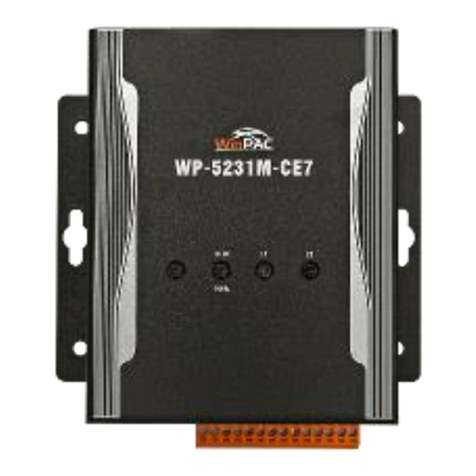
IPC DAS
IPC DAS WP-5231M-CE7 Series quick start

LEGRAND
LEGRAND Wattstopper DLM LMJA-8 Series installation instructions
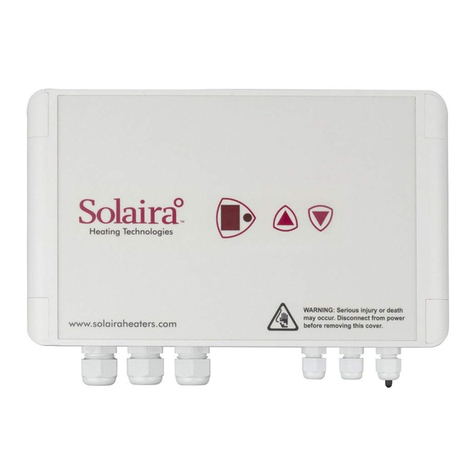
Solaira
Solaira SMaRT 34-DV Installation & user manual
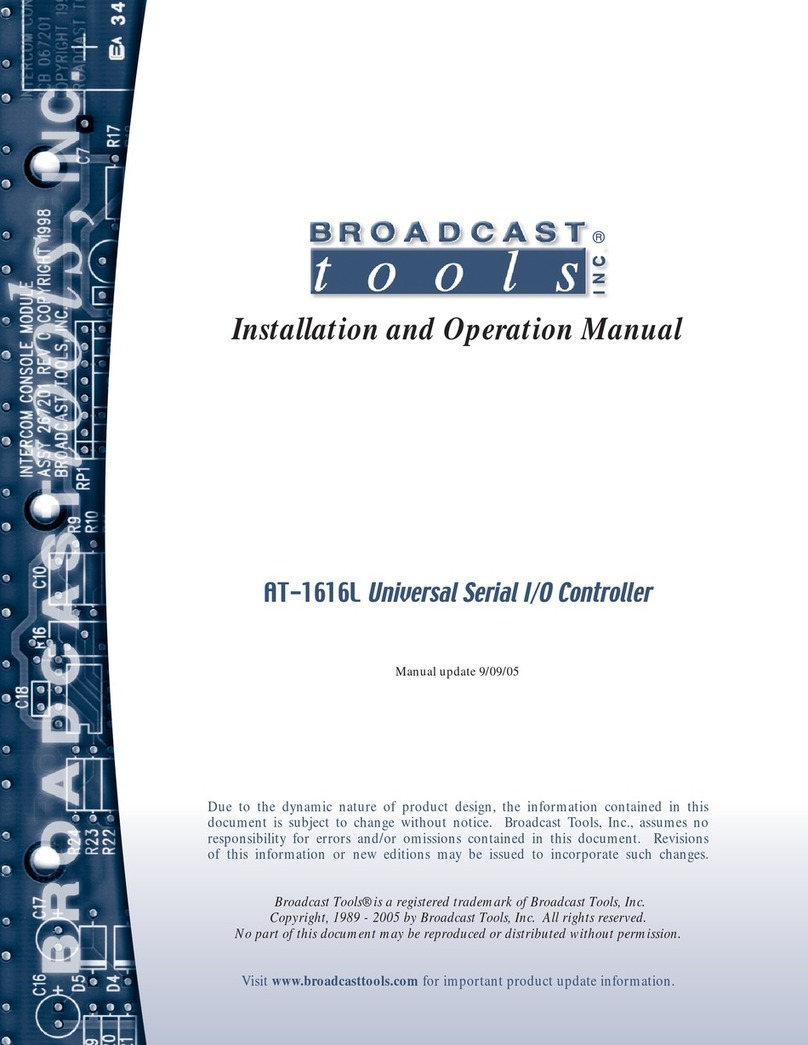
Broadcast Tools
Broadcast Tools AT-1616L Installation and operation manual
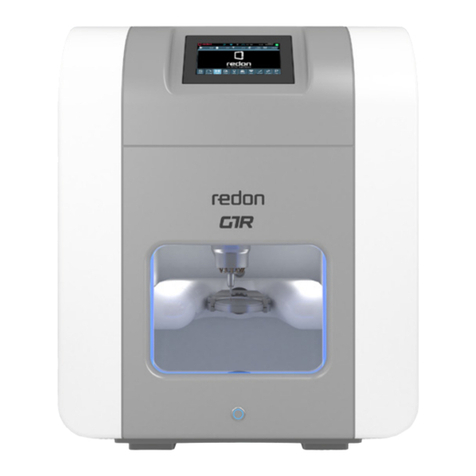
Redon
Redon GTR user manual
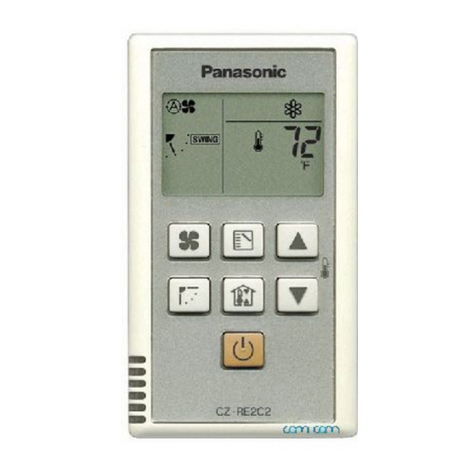
Panasonic
Panasonic CZ-RE2C2 installation manual
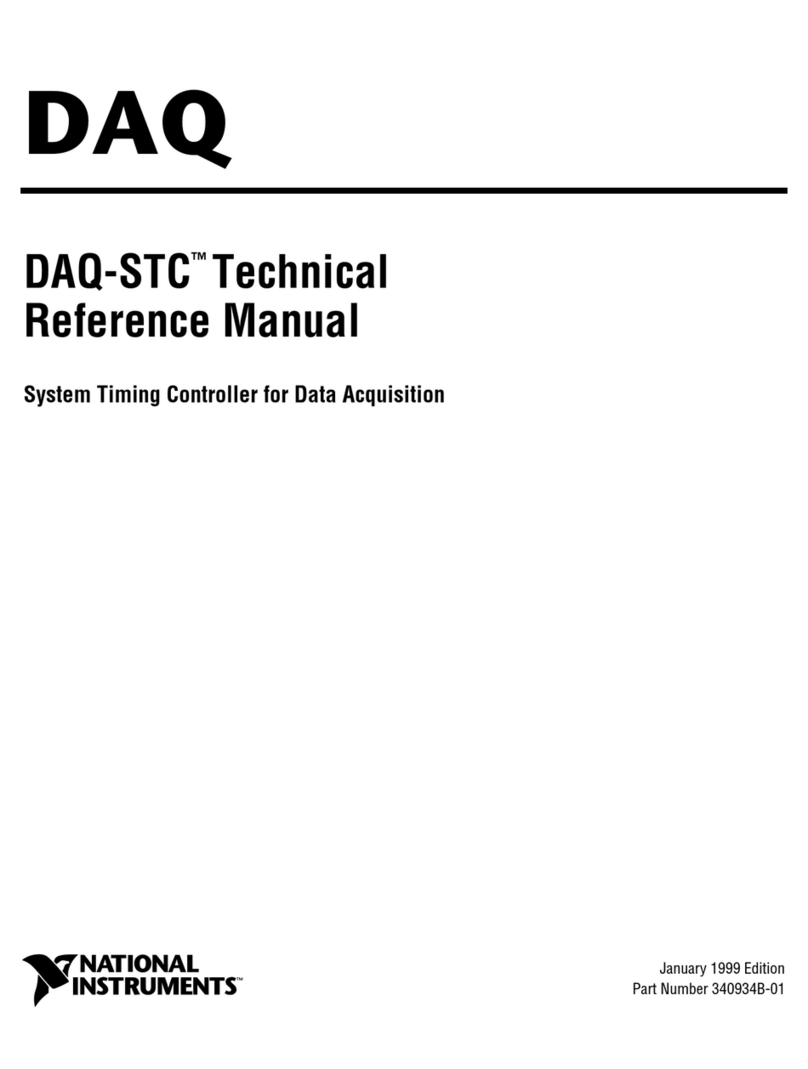
National Instruments
National Instruments DAQ-STC Series Technical reference manual
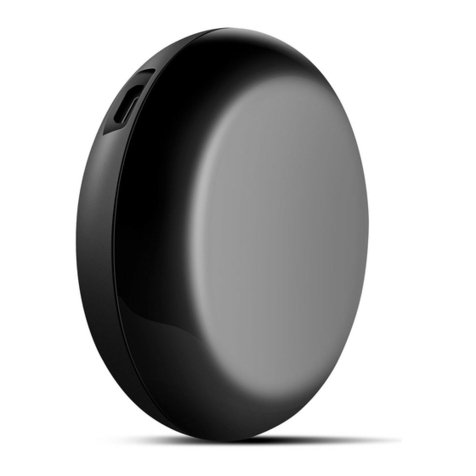
NOUS
NOUS L5 instruction manual
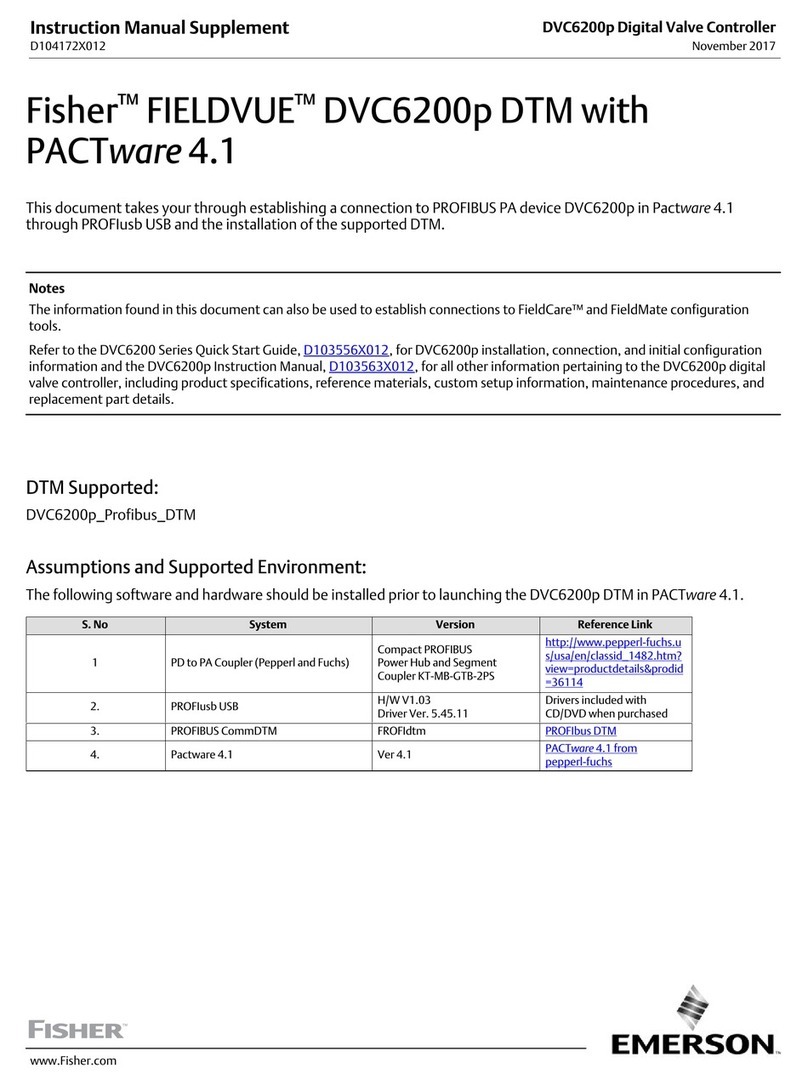
Emerson
Emerson Fisher FIELDVUE DVC6200p Instruction manual supplement
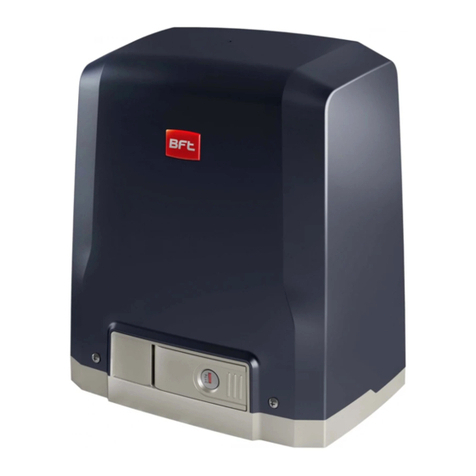
BFT
BFT DEIMOS BT A 600 Installation and user manual
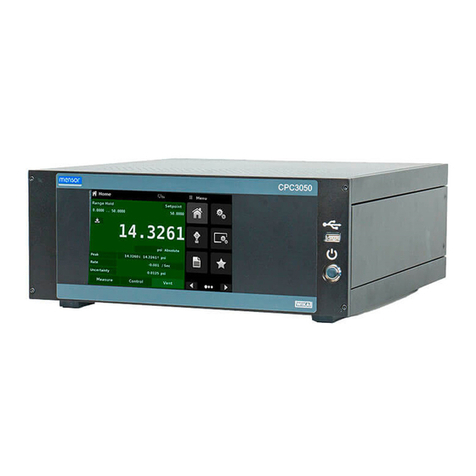
mensor
mensor CPC3050 operating instructions
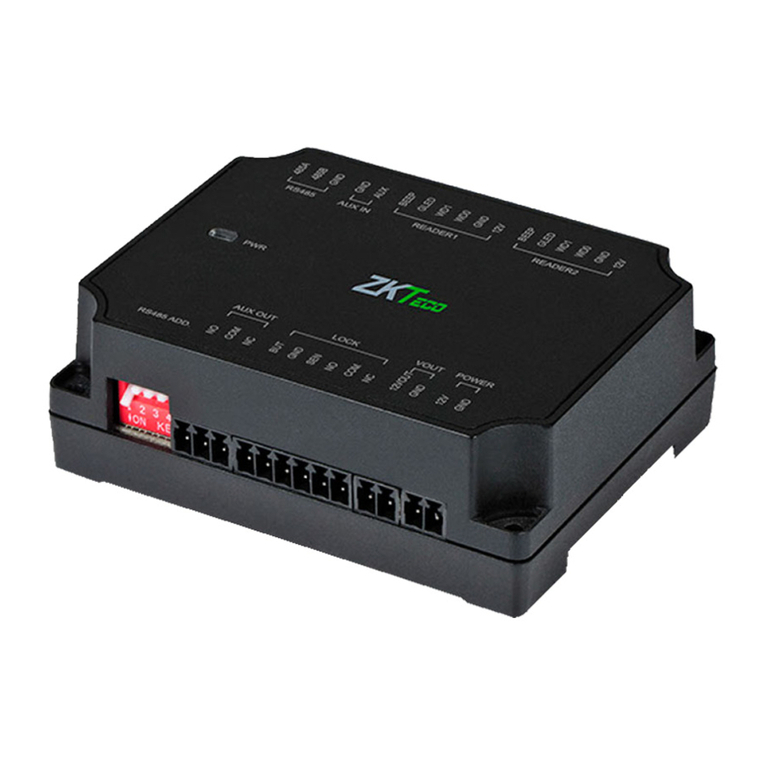
ZKTeco
ZKTeco DM10 quick start guide

